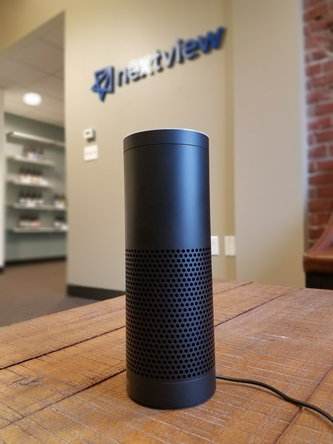David Beisel’s Perspective on Digital Change
Voice Computing in Enterprise: Inside & Out
 We have an Amazon Echo in the NextView Ventures office. Every day I say “good morning” and “good night” to it, and I ask Alexa for my flash news briefing when I walk in the door if I missed it earlier at home. It answers the regular fact-check from team members and guests alike, as well as acts as an easy timer for quick stand-up meetings. As the Alexa platform becomes smarter with more skills, we’ll use it more often in this office setting. While venture capitalists’ offices aren’t your typical corporate environment, just having one around has helped open my own eyes to the potential for voice interfaces in the enterprise.
We have an Amazon Echo in the NextView Ventures office. Every day I say “good morning” and “good night” to it, and I ask Alexa for my flash news briefing when I walk in the door if I missed it earlier at home. It answers the regular fact-check from team members and guests alike, as well as acts as an easy timer for quick stand-up meetings. As the Alexa platform becomes smarter with more skills, we’ll use it more often in this office setting. While venture capitalists’ offices aren’t your typical corporate environment, just having one around has helped open my own eyes to the potential for voice interfaces in the enterprise.
Most of my blog posts to date on personal voice computing have emphasized the personal aspect – what are the services and supporting layers for the consumer? But shortly after one of those posts I received an email from an old friend, head of product / GM at a SaaS company:
Loved your pieces on Voice Computing. Question for you: Do you have a perspective on if / when home voice platforms like Echo & Google Home will become channels for customer support? “Alexa, help me with my X” seems like a very natural way to start a support query. I can imagine hooking up content of our help centers so Alexa can respond to these inquiries, and even connect customers to our call centers. Who would use the phone, look up a phone number, etc. when Alexa can connect you with just the right person?
Outwardly-facing customer support through voice devices, whether it’s for consumer or B2B businesses, seems like a natural extension of the voice paradigm. And frankly, merely an extension of the current mature market of IVR technology in today’s call centers. Yet the possibilities here go beyond a like-for-like help desk – rather, reducing friction to instantly access a voice brand interaction, automated or not, empowers both consumers and the brand marketers who craft those experiences.
However, it’s inside the enterprise where voice has the broader potential to change how we work. It’s not terribly expensive with a Amazon Dot twelve-pack to outfit every conference room in an office environment to make instant access to voice computing ubiquitous. I’ve already read listicles like “7 Reasons to Put Alexa in Your Conference Room” with ideas like ordering supplies or linking the device to the conference room’s calendar for guests to determine room availability.
But the power for voice interfaces is greater when it’s connected to the important information of a company, just like the rest of the connected devices (i.e. laptop terminals) in the environment. Jesus Rodriguez summed it up well in a Chatbots Magazine article: “Alexa has the potential to become a conversational interface gateway for common back-office systems.” Think about the instances where accessing and even inputting critical information will be more naturally done real-time in the context of a voice conversation rather than away or later from a screen UI. It’s already happening. In some cases the giants are taking the lead, like in December Amazon and Salesforce announced Alexa Toolkit for Salesforce, “a collection of technical resources from both… that will let developers build voice-enabled experiences.” In other instances, smaller companies like Appiant are providing the glue to connect services, like Alexa to Workday, to build sophisticated workflows to automate work. The demonstration video of SoftServe’s VoiceMyBot service which connects Atlassian’s HipChat with Alexa is definitely worth watching to begin imagining the possibilities. While I would certainly expect a litany of integration announcements coming from Amazon over the course of 2017, there is certainly room for startups to emerge – both to serve as the specialized “glue” between existing services, as well as to build unique voice-specific applications on top of the platform data accessible through APIs.
While the company is clearly behind Amazon, Google shouldn’t be counted out yet in enterprise voice computing. Even though its moniker suggests its natural place, we have a Google Home device in our NextView offices, too. The company has a natural advantage in the workplace, though, with a combination of its Google Assistant software layer and G Suite of products which are already embedded into a millions of organizations.
Lastly, voice computing interactions may be the most powerful beyond the typical white-collar worker settings. Specialized vertical applications in categories like industrial manufacturing and healthcare provide for settings where handsfree input could be paramount. Bezos himself has recently commented on a future role for Alexa in the hospital and medical care in other settings.
The media attention for voice computing to date has been all about the consumer. After all, that’s where this platform originated. However, especially given the challenges on distribution and monetization for consumer applications and supporting services, the near-term opportunity for startups to emerge leveraging this new paradigm is potentially more likely servicing the enterprise.
